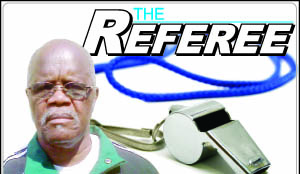 TODAY’S episode is a continuation of last week’s Part one edition of Law 13 which deals with the Free-Kicks. The previous article covered mainly the general provisions of the Free-Kicks Law.
TODAY’S episode is a continuation of last week’s Part one edition of Law 13 which deals with the Free-Kicks. The previous article covered mainly the general provisions of the Free-Kicks Law.
Today, I am covering the interpretation and application of this Law. The covering notes to the last week’s article also attended to most of the fine details of this Law.
Notwithstanding an own allowance, the Laws of the Game require that a goal can only be scored directly from a free-kick against the opposing team. Therefore, if a free-kick say direct or indirect is kicked directly into the team’s own goal, an own goal is not awarded and instead a corner-kick is awarded to the opposing team.
There are two types of free-kick:
Definitions:
• Direct Free-kick: A goal can be scored directly against the opposing team.
• Indirect Free-kick: A goal can be scored only if the ball subsequently touches another player before it enters into goal.
Free-Kick taken by a player other than the goal-keeper:
If, after the ball is in play, the kicker touches the ball again (except with his hands) before it has touched another player:-
• An indirect free-kick is awarded to the opposing team, to be taken from the place where the infringement occurred, unless the infringement occurred inside the goal-area, in which case the kick is taken on the goal-area line parallel to the goal-line at a point nearest to where the infringement occurred.
If, after the ball is in play, the kicker deliberately handles the ball before it has touched another player:-
• A direct free-kick is awarded to the opposing team, to be taken from any point inside that area.
• A penalty-kick is awarded if the infringement occurred inside the kicker’s penalty-area.
Free-Kick taken by the goal-keeper:
If, after the ball is in play, the goal-keeper touches the ball again (except with his hands), before it has touched another player:-
• An indirect free-kick is awarded to the opposing team, to be taken from the place where the infringement occurred, unless the infringement occurred inside the goal-area, in which case the kick in taken on the goal-area line parallel to the goal-line at the point nearest to where the infringement occurred.
If, the ball is in play, the goal-keeper deliberately handles the ball before it has touched another player:-
• A direct free-kick is awarded to the opposing team if the infringement occurred outside the goal-keeper’s penalty-area, to be taken from the place where the infringement occurred.
• An indirect free-kick is awarded to the opposing team if the infringement occurred inside the goal-keeper’s penalty-area to be taken from the place where the infringement occurred or the position of the ball when the infringement occurred.
Procedure:
The ball is in play when it is kicked and moves.
A free-kick can be taken by lifting the ball with a foot or both feet simultaneously.
Feinting to take a free-kick to confuse opponents is permitted as part of football. However, if in the opinion of the referee, the feinting is considered an act of unsporting behaviour, the player must be cautioned.
If a player, while correctly taking a free-kick, intentionally kicks the ball at an opponent in order to play the ball again but neither in a careless nor reckless manner nor using excessive force, the referee must allow play to continue.
An indirect free-kick must be retaken if the referee fails to raise his arm to indicate that the kick is indirect and the ball is kicked directly into the goal. The initial indirect free-kick is not nullified by the referee’s mistake.
Distance:
If a player decides to take a free-kick quickly and an opponent who is less than 9.15 metres from the ball intercepts it, the referee must allow play to continue.
If a player decides to take a free-kick quickly and an opponent who is near the ball deliberately prevents him taking the kick, the referee must caution the player for delaying the restart of play.
If, when a free-kick is taken by the defending team from inside its own penalty-area, one or more opponents remain inside the penalty-area because the defender decides to take the kick quickly and the opponents did not have time to leave the penalty-area, the referee must allow play to continue. – Chileshe_mukuka@yahoo.co.uk or 0966/0978 759






